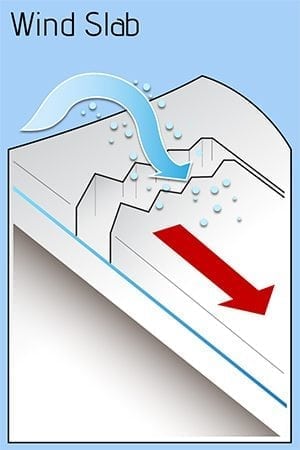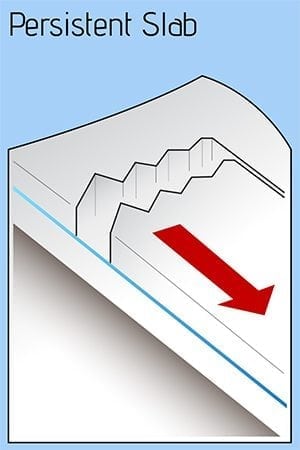Valdez
Above 3,000ftModerate
1,500 to 3,000ftModerate
Below 1,500ftModerate
Degrees of Avalanche Danger
Avalanche Problems
Problem 1
Wind slab avalanches remain possible to trigger up to 1 foot deep in the Thompson Pass/ Valdez area in specific terrain. 4-12 inches of low density snow fell over the last 48 hours depending on location. Moderate – strong north winds accompanied the snow in wind channeled terrain, while other areas remained calm.
On 12/27 wind slabs from the previous wind event(12/23-12/26) were found to be hard and unreactive below 3600′ on southerly aspects. 4-12 inches of low density snow was found on Thompson Pass atop these old wind affected surfaces. Expect to find this new snow redistributed into wind slabs in specific areas such as lee side of high elevation ridge lines and cross loaded gullies.
Look for new wind slabs up to 1 foot deep in areas recently loaded by winds that switched from north to southeast the night of 12/26. Shooting cracks and collapsing are an indicator of unstable snow. In areas unaffected by recent wind good surface stability has been observed atop a base locked up by previously wind damaged snow.
As new snow gains cohesion by settlement expect the distribution of areas capable of producing a human triggered avalanche up to 1 foot in depth to move from specific (wind loaded) to widespread. Although, sensitivity is expected to gradually decrease with benign weather.
Likelihood:
- Almost Certain
- Very Likely
- Likely
- Possible
- Unlikely
Size:
- Historic
- Very Large
- Large
- Small
Trend
- Increasing
- Steady
- Decreasing
Problem 2
Faceted snow near the base of the snowpack has been identified in all three forecast zones. In most locations above brush line, faceted snow is capped by pencil-knife hard wind affected snow. This has created a strong bridging affect above 3000′, making a person or machines weight unlikely to directly affect these layers.
It has been 12 days since the last significant snowfall event, and stability tests that directly target these layers have not been producing significant results lately.
Persistent weak layers are tricky to assess and are notorious for surprising people. As long as temperatures remain cold and our snowpack is thin, these weak layers will continue to lose strength. It is likely that facets will reactivate in the future when stress is being applied through dramatic changes in weather such as: significant snow accumulation or rapid warming. Maintaining safe travel protocols such as skiing one at a time and avoiding traveling in or above terrain traps will increase your safety margin.
The most likely areas to trigger a persistent slab avalanche would be in steep terrain that was protected from previous strong winds that have occurred this season. This could be below brushline in steep open places, or in areas of terrain that are typically spared from outflows. The Continental zone remains suspect as this area has a weaker snowpack and generally receives less wind, which would decrease the bridging affect mentioned above.
Likelihood:
- Almost Certain
- Very Likely
- Likely
- Possible
- Unlikely
Size:
- Historic
- Very Large
- Large
- Small
Trend
- Increasing
- Steady
- Decreasing
Avalanche Activity
Below is a summary of observed Avalanche activity from the last 7 days. Avalanches that were noted earlier in the season can be viewed by clicking the link below.
If you trigger or observe a natural avalanche consider leaving a public observation.
No recent avalanche activity has been recorded in the last 7 days.
Weather
Check out our updated weather tab! A collection of local weather stations are available for viewing with graphs and tabular data included.
NWS Watches and warnings
NONE
NWS Point forecast for Thompson Pass
Date Wednesday 12/28/22 Thursday 12/29/22 Time (LT) 06 12 18 00 06 12 18 00 06 Cloud Cover OV OV OV OV BK BK OV OV OV Cloud Cover (%) 100 95 95 80 55 65 85 85 85 Temperature 18 20 22 18 11 8 7 6 10 Max/Min Temp 24 7 12 5 Wind Dir E E E E NE NE NE NE NE Wind (mph) 6 9 8 6 6 10 11 5 4 Wind Gust (mph) 17 16 Precip Prob (%) 80 70 70 60 20 20 20 5 20 Precip Type S S S S S S S S 12 Hour QPF 0.08 0.05 0.04 0.02 12 Hour Snow 1.3 0.5 0.0 0.0 Snow Level (kft) 0.3 0.3 0.2 0.2 0.1 0.0 0.0 0.0 0.1
Click on link below for Thompson Pass weather history graph:

| Date:
12/28 |
24 hr snow | HN24W* | High temp | Low temp | 72 hour SWE* | December snowfall | Seasonal snowfall | Snowpack Depth |
| Valdez | ~2 | N/O | 29 | 25 | ~.2 | 56 | 91 | 39 |
| Thompson pass | 1 | .03 | 28 | 8 | ~.5 | 89 | 189 | 24 |
| 46 mile | N/O | N/O | 10 | 0 | N/O | ~25 | ~34** | 29 |
*HN24W- 24 hour Snow water equivalent in inches
*SWE– Snow water equivalent
**46 mile seasonal snowfall total begins December 1st.
Additional Information
Click on the link below for a running summary of the seasons weather history.
Announcements
The avalanche hazard is moderate at all elevations. Human triggered avalanches are possible today in areas loaded by recent wind up to 1 foot in depth. Watch out for signs of instability that would indicate a slope has the potential of producing an avalanche. These include shooting cracks and collapsing.
Posted by Gareth Brown 12/28 7:30 am.
For a description of current avalanche problems, weather information, season history and more click the (+ full forecast) button. Avalanche forecasts will be issued Wednesday-Sunday.

